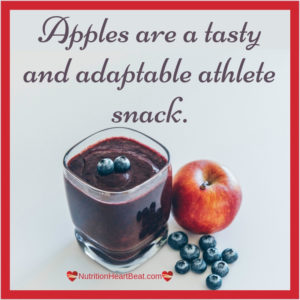As a tasty snack that supports my athletic goals, thanks!
I spend significant amounts of my face to face time with athletes talking about food, as you might expect.
Mostly I talk about protein and vegetables and fruit, but snacks are another common topic. Here I discuss one of my favorite fruits, the apple. It’s hardy, useful for a gym bag or lunch box, and has many health benefits. The frustrating part is that I often have to sell the advantages of fruit. Finding ways to fit an apple into the athlete’s tastes can be a challenge.
Apple history
Are apples the apple of your eye? They should be! One of the most popular fruits on the planet, they’ve been consumed since 6500 B.C. Originating in the area around the Caspian and Black Seas, apples come in an enormous mix of varieties, sizes from smaller than a golf ball to larger than a 16” softball, and colors ranging from a violet red to an orangish yellow, green to a pale brown, as well as striped, streaked and spotted. They were popular in ancient Greece and Rome and an early addition to the fledgling colonies of North America.
Apples really do come in thousands of varieties, too. Check out this UK website, Orange Pippin, that lists the options available if you’re willing to do a little detective work. Their orchard list has orchards from around the world, so if you’re interested in picking your own, you can find a spot close to you. The list of varieties expands when you consider the wild trees and unnamed varieties found in western Asia and around the world.
The native American apple, the crab apple, is technically edible, but unlike our standard eating apples, has been bred for looks instead of flavor. So beware – you might get a poor-tasting snack if you try to eat one!
Athlete uses

Apples are useful snacks, either for pre/post workout fueling or for a mid-day energy boost. Because they’re shelf stable and relatively sturdy, they can be thrown in a backpack, computer bag, or gym bag – just keep them away from your cleats! Dried apples are also a fine choice, just be aware that the portion size is 1/4 cup. Dried fruit can be deceptively calorie-laden because it’s so dense. Any grocery store will have apples available, as will some convenience stores, and they’re increasingly found as optional sides at some restaurants and even fast food venues.
Carbohydrates!
For athletes who are extremely careful about their carbohydrate intake, they’re a whole-food way to get a relatively consistent amount of carbohydrate. Most of that carbohydrate is sugar but some of it is fiber. No worries on the sugar – the World Health Organization clearly states that sugar that’s part of fruit or dairy is fine because the nutrients found in the rest of those foods outweigh any risks from the sugar. The sugar in apples will be mixed in with fiber, negating any blood glucose rise anyway.
The fiber is a big win, as most people in the United States fall very short on the amount of fiber they consume. Fiber supports a healthy gut microbiome, which in turn supports a healthy set of intestines and a normally-functioning immune system. Some athletes do find that some types of carbohydrate, such as those in apples, can cause GI distress during exercise. This can be addressed by determining FODMAP exposure and eliminating those fermentable carbohydrates that bother an athlete on an individual basis.
There are other nutrients?
What about nutrients beyond fiber? Apples have potassium and small amounts of other vitamins and minerals. They also have a variety of phytochemicals that work as antioxidants and anti-inflammatory compounds; the most well-characterized in apples is quercetin.
Eating options (i.e. pie!)
And of course, beyond eating fresh or dried apples, what else can you do with the vaunted apple?? They’re used in savory dishes for autumn, such as roasted with pork and onions, and you can add them to stuffing. Applesauce is a popular side or snack and very easy to make as long as you’re handy with a peeler or paring knife. Apples go well in chicken salad, providing a bit of sweetness and crunch, and in regular salad with vegetables. Try one with roasted veggies! They fit well in fall soups, particularly pureed soups, such as a squash-apple soup.
On the sweeter side, you can cook applesauce down into apple butter and use it as a spread. Roasted apples are quite tasty, especially when cored and stuffed with nuts and cinnamon! Pies are classic, either solo, with ice cream or with cheddar cheese, as is a rustic apple galette. For a French twist, try a tart tatin, or for a German twist, apple strudel. Apple brown betty is old school but still delicious. Apple crisp has devoted fans, and breakfast can become dessert with apple pancakes or an apple compote on top of pancakes, waffles or crepes. Fresh or dried apples can be used in apple cakes and cookies, especially if caramel is involved.
As for liquid options, apples can be turned into ice cream, gelato and granitas, plus brandy and applejack. Apple juice, sauce or butter can be added to smoothies, usually with a stronger flavored fruit. Don’t forget apple cider, either fresh or hard, and apple cider vinegar, useful for adjusting flavors and vinaigrettes. Whew! At least one of those should appeal to every athlete!
Need help?
If you’re an athlete and you know you need to eat more apples or fruit or vegetables, but you’re struggling to make it happen, consider the Motivational Coaching Program. If you’re a coach, have me talk to your team to improve their snack game. Pro tip: team talks are usually free! If you just have questions about apples, reach out to me here or on social media!
